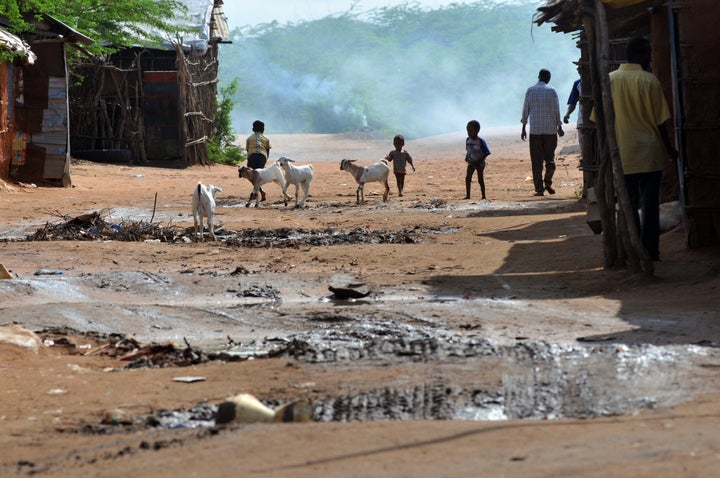
"The drought has gotten so bad that we have seen camels dying of thirst," recounted a Mercy Corps colleague during my recent visit to Somalia. While crises in Sudan, Libya and Japan may get the headlines, the worst humanitarian crisis in the world today -- by a long shot -- is taking place in the Horn of Africa. Experts in the region say that the drought is the worst the Horn has seen since the 1950s. The U.N. estimates that more than 10 million people face severe food shortfalls. Spanning across Somalia, Kenya and Ethiopia, the current crisis could prove to be worse than the far better-known crisis in Ethiopia in the 1980s, which ultimately killed up to 1 million people.
The epicenter of the crisis is Somalia, where nearly 3 million people -- more than one-third of the population -- face possible starvation. Mercy Corps staff in the country, people with years of experience in humanitarian relief, have told me that this is one of the worst situations they have ever seen.
Yet as Somalia has descended closer to outright famine, the U.S. government has largely stayed on the sidelines, contributing only $14.5 million -- a tiny fraction of the need -- for food aid this year. The U.S. is the largest global donor to international hunger relief, so when the U.S. fails to show up, there is no one else who can be relied on pick up the slack.
Why is the U.S. doing so little to respond? Politics. In 2008, when most of Somalia's territory was occupied by Ethiopian troops in support of a U.S.-allied Somali government, the U.S. contributed 10 times more humanitarian aid to Somalia than it has this year. But when the Ethiopians pulled out in early 2009, most of southern Somalia was forcibly taken over by militant movements that the U.S. had designated as terrorists.
The shift in political control of the territory spurred drastic cuts in U.S. humanitarian aid due to overly broad U.S. laws on terrorist financing. As conditions in the country have worsened, U.S. laws on material support to terrorists have become a direct impediment to the drought response: the U.S. has avoided any humanitarian activity that might result in even a small amount of aid leakage to the militants. There is a safety valve for situations like this: a humanitarian exemption that the State Department could request from the Treasury Department. But State and Treasury have shown little interest in going that route.
Avoiding aid diversion is a reasonable goal, and one that humanitarian groups like Mercy Corps share. But the U.S.'s overzealous approach to this challenge now threatens to write off millions of Somalis who face the very real risk of starvation. As things stand now, the U.S. has withheld hunger assistance to the nearly 2 million desperately hungry civilians in areas that the militants control. Even in areas controlled by clans who actually oppose the southern militias, such as hard-hit communities of central Somalia, exaggerated USG fears about aid leakage have resulted in the U.S. providing only very limited support.
U.S. policy is not the only obstacle: the militant groups in the south bear substantial responsibility as well. The militants have imposed unacceptable conditions on aid groups, such as requiring that female staff be fired, and demanding extortionate payments. Caught between U.S. legal restrictions and the militants, Mercy Corps and most other international relief groups were forced to leave southern Somalia last year.
These obstacles are now costing lives. Huge numbers of Somalis depend on agriculture and livestock to survive, and they have been devastated: as harvests have failed, they are deprived of their local food; as their livestock have died, they no longer have income to buy imported food. The drought has left them without viable options for feeding themselves, and aid is nowhere in sight. In the absence of sufficient aid, hunger is now forcing tens of thousands of people to flee the country every month. Nearly half of the children who flee are malnourished, and reports are emerging of families burying children en route as they make their way to neighboring countries. Shockingly, those who make it out are the lucky ones; many more within Somalia are too poor or too weak to leave.
The U.S. could easily take a first step toward improving the situation by drastically ramping up humanitarian support to hard-hit northern and central Somalia, which remain outside militant rule. In the militant-controlled areas of southern Somalia, the situation is bleaker. There may be a way forward, but it will require flexibility from both sides. In the past, the U.S. has allowed food aid programs in politically sensitive areas with tightly controlled monitoring to ensure that food reaches its intended recipients. The militants in the south have just announced that they are willing to allow international relief groups to return, though the full details of this announcement are still being explored. If this looks like a serious opening, the State-Treasury "safety valve" that I mentioned earlier would enable the US to restart aid -- if the U.S. government felt inclined to use it.
If the militants in southern Somalia prove willing to allow open access for humanitarian groups, including robust monitoring, will the U.S. government be open to restarting aid? Or will several million people be consigned to starvation?